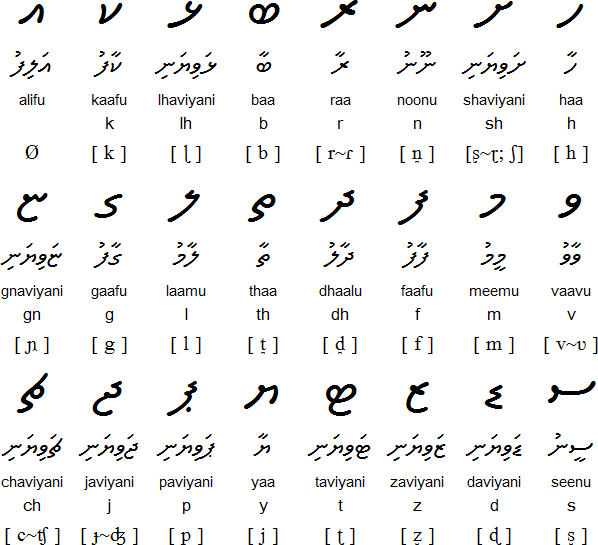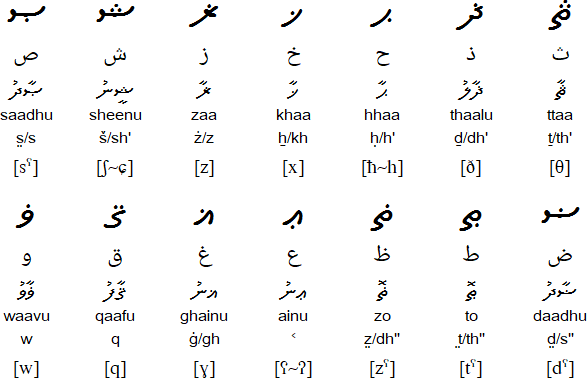Origin
The Thaana script was developed during the 18th century by an unknown inventor. It first appeared in government documents in 1703 and replaced an older alphabet known as Dhives akuru.Some of the Taana letters were derived from Dhives akuru, while others were modelled on Arabic numerals. Vowel indication is modelled on the Arabic system of diacritics.
Notable features
- Words are written from right to left, but numerals are written from left to right.
- Originally Arabic numerals were used, however nowadays Western numerals (1, 2, 3, etc) are used.
- Vowels are indicated with diacritics which appear above or below the consonants. When vowels are come at the beginning of a word or are pronounced separately, they are attached to the letter alifu.
- When the sukun symbol is combined with the letter alifu it either doubles the following consonant, or if it appears at the end of a word after an "e", it adds and "h" sound.
- A number of letters are used solely for writing Arabic loan words.
Used to write:
Dhivehi (Maldivian), an Indo-Aryan language spoken by about 300,000 people in the Maldives and on India's Minicoy Islands.Thaana consonants

Thaana vowel diacritics

Letters used for transliterating Arabic words (thiki jehi thaana)
Top row: Thaana letters, bottom row: the Arabic letters on which they are modelled

Note
the letter zaa is also used to write the English sound /ʒ/.Download the script charts (Excel format)
Sample texts

Transliteration
Hurihaa insaanun ves ufanvanee, dharaja'aa'i ḥa'quthakuga'i minivankamaa'i hamahamakan libigenvaa ba'e'ge gothuga'eve. Emeehunnash heyo visnumaa'i, heyo bu'dheege baaru libigenva'ava. Adhi emeehan ekaku anekakaa medhu mu˂aamalaath kuranvaanee, ukhu'vaththeri kamuge rooḥe'ga'ava.Translation
All human beings are born free and equal in dignity and rights. They are endowed with reason and conscience and should act towards one another in a spirit of brotherhood.(Article 1 of the Universal Declaration of Human Rights)

Transliteration
al'la'ufedhey qaanoonu asaaseege himaayaïlibigen siyaaseepaateetha' hingeynegoïtha' hamajehifaïneïnama e'qaanoonuge misaalakee alifaanroavej'jenama salaamaïvaane sidie'neï ethake'bureege imaaraathe'ge misaaleve.Translation
A newly formed constitution which does not give protection to political parties under it terms, is equivalent to a multi-storey building with no fire exits.The sample text comes from the Maldivian news paper Sandhaanu, 15th August 2002
Links
Information about the Dhivehi language and Thaana scripthttp://en.wikipedia.org/wiki/Divehi_language
http://en.wikipedia.org/wiki/Thaana
http://www.maldivesculture.com/thaana01.html
Free Thaana fonts
http://www.wazu.jp/gallery/Fonts_Thaana.html
http://www.haveeru.com.mv/downloads/fonts.zip
http://www.mitf.net/index.php/projects/thaana/font-unicode.html
http://all1.thefreebizhost.com/Fonts.htm
http://www.saturn.in/foss/thanaunicode/ (Linux)
Dhivehi thaana - reading and writing the Maldivian language
http://www.maldivesculture.com/thaana01.html
Divehi phrases
http://maldives.tourism-srilanka.com/travel-tips/useful-phrases.html
http://wikitravel.org/en/Dhivehi_phrasebook
Send email in the Thaana script
http://themaldiveislands.com/web2/tmi.phtml?pimt=4
Haveeru Online - online version of a daliy newspaper in Divehi and English (uses dynamic fonts): http://www.haveeru.com.mv
Maldives websites
http://www.visitmaldives.com.mv
http://www.maldive.com
No comments:
Post a Comment
Note: Only a member of this blog may post a comment.